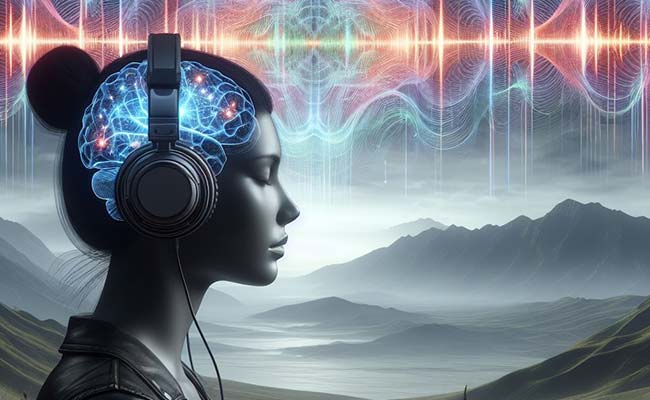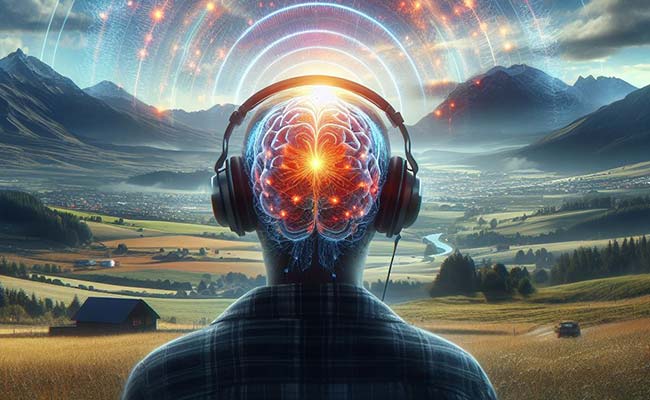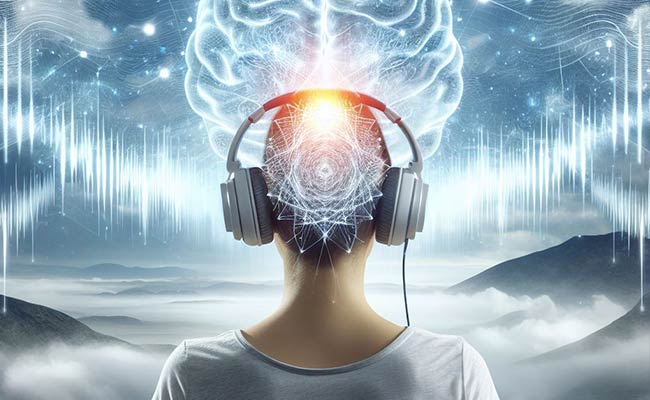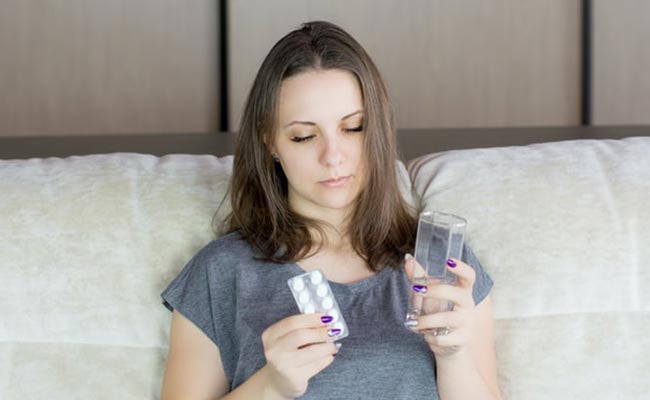A common question people ask is whether or not there is any scientific research behind binaural beats?
Well, yes, there is quite a lot, but it isn't heavily publicized or publicly documented; that is to say that the average person wouldn't hear about it.
Moreover, funding for natural therapies like this tends to be very limited, so the number of studies conducted is far smaller than for more popular areas of medicine, and post-research PR has limited reach.
Like most people, you probably find it pretty boring to plough through scientific papers and read all the technical jargon. So, in this post, I have provided an easy-to-digest summary of the results of a variety of binaural beats studies.
Where the study is available online, I have linked to its source so that you can follow it up and read further details.
I have covered key areas of general interest such as anxiety, memory, pain relief, and sleep.
I hope you find this information useful. I will continue to add additional studies to this page as they become available.

1. Research: Stress
This section of research covers the effectiveness of using binaural beats for stress relief, pain management, healing and general relaxation:
1) Efficacy of Binaural Beats as a Stress-buffering Technique
This pilot study sought to examine how theta binaural beat (TBB) auditory stimuli impact stress levels induced by the Trier Social Stress Test (TSST). The study included 64 adults recruited from a private Midwestern university, randomly assigned to either an intervention or control group. Participants completed self-report assessments on auditory stimuli, perceived stress, and mindfulness before engaging in the TSST. Throughout the study, heart rate variability (HRV) was recorded to measure physiological responses.
Results indicated that both groups experienced a significant increase in psychological stress from exposure to stimuli to the TSST. However, the intervention group, exposed to TBBs, showed a greater parasympathetic dominance during the TSST compared to the control group. This suggests that TBB exposure may mitigate stress responses to acute psychological stressors, as evidenced by higher heart rate variability in the intervention group during the TSST. Overall, the study suggests a potential role for TBB auditory stimuli in reducing stress reactivity to challenging situations.
2) A Comprehensive Review of the Psychological Effects of Brainwave Entrainment
The study conducted a systematic review of literature from peer-reviewed journals on the psychological effects of brainwave entrainment (BWE), a technique using rhythmic stimuli to alter brainwave frequency and states.
They aimed to raise awareness of BWE and discuss its potential therapeutic benefits. Twenty studies were selected from databases such as OVID Medline, PsychInfo, and Scopus, focusing on experimental and quasi-experimental designs with psychological outcomes.
The selected studies addressed various psychological outcomes, including cognition, stress and anxiety, pain relief, headaches or migraines, mood, behavior, and premenstrual syndrome (PMS). Different protocols were used, including single, alternating, ascending, or descending frequencies, as well as auditory and/or photic stimulation.
Results indicated that BWE showed promise as an effective therapeutic tool, benefiting individuals with cognitive deficits, stress, pain, headaches, migraines, PMS, and behavioral problems.
3) Stress management using fNIRS and binaural beats stimulation
This study investigated the efficacy of binaural beats stimulation (BBs) in improving cognitive vigilance and reducing mental stress levels in the workplace. Four cognitive conditions were examined: high vigilance (HV), vigilance enhancement (VE), mental stress (MS), and stress mitigation (SM), with the VE and SM conditions involving listening to 16 Hz of BBs. Various measures including salivary alpha-amylase, behavioral responses, and Functional Near-Infrared Spectroscopy (fNIRS) were used to assess vigilance and stress levels.
Results indicated that listening to 16-Hz BBs significantly decreased alpha-amylase levels by 44%, reduced reaction time to stimuli by 20%, and increased accuracy of target detection by 25%. Analysis of connectivity networks across different conditions revealed significant increases in connectivity between specific brain regions during VE and SM compared to other conditions. Overall, the study shows that BBs can effectively enhance vigilance and mitigate stress in workplace settings.
2. Research: Pain
1) Binaural beats reduce feeling of pain and discomfort during colonoscopy procedure in not-sedated patients: A randomized control trial
This study investigated the impact of Binaural Beats (BB) on pain perception and patient comfort during colonoscopy without sedation. A randomized, controlled, double-blind procedural study was conducted involving 115 patients.
Patients were randomly assigned to either the experimental group (n = 42) or the control group (n = 48), with the experimental group receiving BB starting 5 minutes before and continuing until the end of the colonoscopy procedure. Measures of anxiety (VAS-Anxiety scale) were collected before the procedure, and pain perception (Visual Analogue scale VAS-pain), satisfaction, and willingness to repeat the procedure were assessed immediately after the colonoscopy.
Results showed that the experimental group reported lower levels of pain and higher levels of comfort compared to the control group (p < 0.05). The study concluded that BB is an effective and safe method for reducing pain and improving patient comfort during colonoscopy without sedation. Given its non-pharmacological, non-invasive nature and lack of side effects, BB may serve as a valuable tool to alleviate pain and discomfort for non-sedated patients undergoing colonoscopy.
2) Reduced pain and analgesic use after acoustic binaural beats therapy in chronic pain – A double-blind randomized control cross-over trial
This study aimed to investigate the effect of Binaural Beats (BB) on pain perception and analgesic medication use in chronic pain patients. In a double-blind, randomized, cross-over trial, BB at 5Hz were applied for 30 minutes, followed by liberal use over a week, compared to sham stimulation (SS). Pain intensity, stress levels, and medication usage were assessed at various time points.
Results showed that perceived pain was significantly reduced in the BB intervention group compared to SS, both immediately after the 30-minute phase and at the week's end. Stress levels were also reduced in both groups initially, but only remained reduced in the BB group by the end of the week. Furthermore, analgesic medication consumption during the week was significantly lower in the BB group compared to SS.
The study concludes that acoustic BB can effectively reduce pain intensity, stress, and analgesic medication use in chronic pain patients. These findings suggest that theta rhythm binaural beats could serve as a valuable adjunct to existing pain therapies, potentially offering relief for chronic pain sufferers.
3. Efficacy of binaural auditory beats in cognition, anxiety, and pain perception: a meta-analysis
This meta-analysis aimed to investigate the impact of binaural beats on memory, attention, anxiety, and analgesia. Twenty-two studies were included, totaling 35 effect sizes. The results revealed a medium, significant, and consistent effect size overall. Meta-regression analysis indicated that masking binaural beats with white or pink noise did not significantly affect their effectiveness compared to unmasked beats.
Additionally, exposure to binaural beats before and during a task produced better results than exposure during the task alone. Longer periods of exposure were also found to be more effective. Overall, the findings suggest that binaural beats can positively influence cognition, anxiety levels, and pain perception without prior training. The effectiveness depends on factors such as frequency, duration of exposure, and timing of exposure.
4. The Effect of Binaural Beat Audio on Operative Pain and Anxiety in Cataract Surgery under Topical Anaesthesia: A Randomized Controlled Trial
This prospective, randomized controlled trial aimed to investigate the analgesic and anxiolytic effects of binaural beat audio in patients undergoing cataract surgery under topical anesthesia. Sixty-one patients were divided into two groups: the binaural beat audio group and a sham-control group. The study measured pain levels using a visual analog scale (VAS) immediately after surgery and assessed anxiety using the State-Trait Anxiety Inventory questionnaire. Blood pressure and heart rate were also monitored pre- and post-intervention.
Results showed that the binaural beat group had significantly lower pain scores, heart rate, diastolic blood pressure, mean arterial pressure, and anxiety levels compared to the control group. Within the binaural beat group, subjects experienced a significant reduction in heart rate and anxiety levels compared to baseline values. This study suggests that binaural beat audio may effectively decrease operative pain and anxiety during cataract surgery under topical anesthesia and could potentially modulate the stress-induced tachycardic response.

3. Research: Memory
1) The Effect of Binaural Beats on Visuospatial Working Memory and Cortical Connectivity
This study investigated the effects of different acoustic stimulation conditions, including binaural beats, on participant response accuracy and cortical network topology during a visuospatial working memory task. Participants were exposed to various auditory stimuli, including classical music and different frequencies of binaural beats.
Results showed that listening to 15Hz binaural beats improved response accuracy and modified cortical network strengths during the task. In contrast, the other auditory conditions, including lower frequency binaural beats and classical music, decreased accuracy. Graphical network analyses revealed that cortical activity during 15Hz binaural beats exhibited networks indicative of high information transfer and consistent connection strengths throughout the working memory task.
2) Studying frequency processing of the brain to enhance long-term memory and develop a human brain protocol
This study aimed to investigate the relationship between gamma wave activity and long-term memory processing in the human brain. Fifty-eight participants across a wide age range took part in long-term memory experiments. The study suggests that stimulating the brain with binaural beats at 40 Hz (gamma frequency) may enhance long-term memory capacity. Statistical analysis revealed a proportional relationship between long-term memory and gamma activity.
EEG recordings were transformed into sound and then into ASCII format, revealing a pattern indicative of this relationship. The findings suggest the potential for further research to develop a human brain protocol that could facilitate direct processing of information to and from human memory via gamma waves, the hippocampus, and the temporal lobe.
3) Binaural auditory beats affect long-term memory
This study aimed to investigate the impact of binaural auditory beats on long-term memory. Participants were exposed to binaural auditory beats in either the beta (20 Hz) or theta (5 Hz) frequency bands, as well as white noise as a control condition. Following exposure, participants performed free recall and recognition tasks.
Results showed that exposure to beta-frequency binaural beats led to better recall and recognition performance compared to theta-frequency beats. These findings suggest that binaural auditory beats can influence long-term memory positively or negatively, depending on the frequency utilized.
4) Effects of inaudible binaural beats on visuospatial memory
This study aimed to investigate the effects of inaudible binaural beats on visuospatial memory. Eighteen adult subjects underwent two phases: a rest phase and a task phase involving a 3-back task with and without binaural beats stimulation.
Results showed that task performance with binaural beats stimulation led to significantly higher accuracy and shorter reaction times compared to the task-only condition. Additionally, electroencephalogram analysis revealed a lower reduction in alpha power in all brain areas, except the frontal, during task performance with binaural beats. These findings suggest independent effects of binaural beats stimulation on visuospatial memory.
5) Potential of binaural beats intervention for improving memory and attention: insights from meta-analysis and systematic review
This study aimed to investigate the effect of binaural beats (BB) intervention on memory and attention through meta-analysis and systematic review. Fifteen studies met the inclusion criteria, with results indicating a medium and significant effect size for BB intervention on memory and attention.
However, systematic review findings revealed conflicting results, especially regarding the efficacy of theta and beta frequencies on memory and attention-related tasks. The study suggests the potential of BB intervention in improving memory and attention but highlights the need for further research with robust study designs to explore its guiding principles and expand its role in enhancing cognitive functions.
4. Research: Anxiety
1) Use of binaural beat tapes for treatment of anxiety: a pilot study of tape preference and outcomes
This study aimed to investigate the effects of listening to tapes embedded with tones creating binaural beats on anxiety levels in mildly anxious individuals over a period of one month. Conducted as a 1-group pre-posttest pilot study, the participants, consisting of 15 mildly anxious patients from Clinique Psyché in Montreal, Quebec, were asked to listen to one or more of three music tapes containing tones producing binaural beats in the electroencephalogram delta/theta frequency range. The intervention involved listening to the tapes at least five times weekly for four weeks, with participants recording their tape usage, anxiety ratings, and tape preferences in daily journals.
The main outcome measures included anxiety ratings before and after tape listening, pre- and post-study State-Trait Anxiety Inventory scores, and tape preferences documented in daily journals. Results indicated a significant reduction in daily anxiety scores reported by participants, with the number of times tapes were listened to ranging from 10 to 17 over the four-week period. End-of-study tape preferences revealed a slight preference for tape B, which featured pronounced and extended patterns of binaural beats.
While changes in pre- and post-test State-Trait Anxiety Inventory scores trended toward a reduction in anxiety, these differences were not statistically significant. The study concluded that listening to binaural beat tapes in the delta/theta electroencephalogram range may be beneficial in reducing mild anxiety. However, future studies should consider factors such as music preference, age, incentives for tape listening, and physiological measures of anxiety reduction. Additionally, controlled trials incorporating binaural beat tapes as an adjunctive treatment to conventional therapy for mild anxiety may be warranted.
2) Binaural beats or 432 Hz music? which method is more effective for reducing preoperative dental anxiety?
This prospective clinical study aimed to assess the effectiveness of binaural beats and 432 Hz tuned music in reducing preoperative dental anxiety during impacted third molar surgery. Ninety patients were randomly assigned to the binaural beats group, music group, or control group.
Dental anxiety was evaluated using a visual analog scale before and after intervention. Both the binaural beats and music groups showed a significant decrease in anxiety compared to the control group. The findings suggest that binaural beats and 432 Hz tuned music can serve as non-pharmacological adjuncts to reduce dental anxiety during surgery.
3) Effects of Listening to Binaural Beats on Anxiety Levels and Pain Scores in Male Patients Undergoing Cystoscopy and Ureteral Stent Removal: A Randomized Placebo-Controlled Trial
The State-Trait Anxiety Inventory (STAI) and Visual Analog Scale (VAS) were used to measure anxiety and pain scores, respectively. The results showed that listening to pure binaural beats significantly reduced anxiety levels and pain scores compared to the control group, suggesting that binaural beats may be a simple and effective method to alleviate anxiety and pain associated with these procedures in male patients.
4) Comparative evaluation of anxiety level during restorative treatment using no music, monaural beats, and binaural auditory beats as audio distraction behavior guidance technique in children aged 6-12 years: A randomized clinical trial
This study aimed to assess and compare anxiety levels during restorative dental treatment in children aged 6-12 years using different audio distraction techniques: no music, monaural beats, and binaural auditory beats. A total of 45 participants were allocated into three groups, and anxiety levels were measured before and after the intervention using pulse oximetry and Venham's picture test.
The results showed that both binaural auditory beats and monaural beats were effective in reducing anxiety levels compared to the control group, with binaural auditory beats demonstrating the most significant reduction. This suggests that binaural auditory beats and monaural beats can serve as effective aids in alleviating anxiety in pediatric dental patients.
+ Buy Binaural Beats That Work – Find Out Where!

5. Research: Sleep
1) Brainwave entrainment for better sleep & post-sleep state of young elite soccer players
This study aimed to investigate the potential improvement in sleep quality and post-sleep psychophysical states among top athletes through auditory brainwave entrainment. Conducted as a pilot study, the research involved 15 young elite soccer players who were stimulated during sleep with binaural beats around 2-8 Hz for eight weeks. Participants completed questionnaires assessing sleep quality, psychophysical and motivational state, and sleep and awakening quality once a week after waking up.
The intervention group showed significant improvements in subjective ratings of sleep and awakening quality, sleepiness, and motivational state compared to the control group. The findings suggest that auditory stimulation with binaural beats over eight weeks can enhance perceived sleep quality and post-sleep states among athletes. However, the effect on physical performance may occur in a time-delayed manner.
In summary, the study highlights the potential benefits of auditory brainwave entrainment for improving sleep quality and post-sleep states in athletes.
2) Effect of Dynamic Binaural Beats on Sleep Quality: A Proof-of-Concept Study with Questionnaire and Biosignals
This study investigated the effectiveness of a new form of binaural beat (BB) called dynamic BB (DBB) in enhancing sleep quality. DBB involves dynamically changing carrier frequency differences between the left and right ears. Ten healthy participants experienced both DBB and a SHAM condition across two consecutive nights, with polysomnography evaluation.
Results showed that DBB significantly reduced sleep latency compared to the SHAM condition. Additionally, electrocardiogram analysis revealed decreased heart rate variability and low-frequency power of heart rate during specific sleep stages with DBB. These findings suggest that DBB may be effective in improving sleep quality and could be considered for insomnia treatments.
3) Entrapment of Binaural Auditory Beats in Subjects with Symptoms of Insomnia
This study investigated the effects of binaural beat (BB) stimulation as a supplementary therapy for insomnia. Participants with subclinical insomnia symptoms used an apparatus with or without 6 Hz BB for 30 minutes before bedtime for two weeks. Quantitative electroencephalography (EEG) was measured before and after the intervention.
Results showed that listening to music with BB led to an increase in relative theta power, particularly in the occipital and parietal regions. Additionally, after two weeks of BB intervention, a decrease in beta power was observed, indicating reduced hyper-arousal. These findings suggest that exposure to music with BB may help reduce hyper-arousal and contribute to sleep induction.
4) Examining the effects of binaural beat music on sleep quality, heart rate variability, and depression in older people with poor sleep quality in a long-term care institution: A randomized controlled trial
This study investigated the effects of binaural beat music (BBM) on sleep quality, heart rate variability, and depression in older individuals with poor sleep quality in a long-term care institution. Sixty-four participants were randomly assigned to either the BBM group or the control group for a 14-day intervention period. The BBM group listened to Taiwanese Hokkien oldies embedded with BBM twice daily, while the control group listened to the same music without BBM.
Results showed significant improvements in sleep quality, heart rate variability, and depression severity in the BBM group compared to the control group. These findings suggest that BBM intervention could be a non-invasive approach to improve sleep and reduce depression in older individuals with poor sleep quality in long-term care settings.
5) Possible Effect of Binaural Beat Combined With Autonomous Sensory Meridian Response for Inducing Sleep
This study aimed to develop a novel auditory stimulus to induce sleep by combining binaural beats with autonomous sensory meridian response (ASMR) triggers. Binaural beats, generated by two tones in each ear, were set to a 6 Hz frequency corresponding to the theta brainwave band associated with non-rapid eye movement (NREM) sleep stage 1. ASMR triggers, known for inducing feelings of calmness and relaxation, were incorporated from natural sounds. I
n session 1, different combinations of binaural beats and ASMR triggers were tested to find the optimal ratio, with a 30:60 dB ratio being most effective. In session 2, this combined stimulus (CS) was compared to binaural beats alone, ASMR triggers alone, and a sham condition.
Results showed that the CS retained the benefits of binaural beats while addressing shortcomings with ASMR triggers, resulting in improved psychological comfort and induction of brain signals conducive to sleep. This novel auditory stimulus presents an opportunity to enhance sleep quality effectively.
6. Research: Addiction & Depression
1) Alpha-theta brainwave training and beta-endorphin levels in alcoholics
In this study, an alpha-theta brainwave biofeedback training program was introduced as a novel treatment approach for chronic alcoholics. Experimental subjects underwent 15 sessions of alpha-theta biofeedback training following a temperature biofeedback pretraining phase.
Compared to nonalcoholic and traditionally treated alcoholic control groups, alcoholics who received brainwave training (BWT) exhibited significant increases in alpha and theta brainwave percentages, along with higher alpha rhythm amplitudes. Across the 15 sessions, alcoholics undergoing BWT showed progressive enhancements in alpha and theta brainwave activities.
Furthermore, these experimentally treated alcoholics reported notable reductions in self-assessed depression levels, as measured by Beck's Depression Inventory, compared to the control groups. Conversely, alcoholics undergoing standard medical treatment, including abstinence, group psychotherapy, and antidepressants, demonstrated a significant rise in serum beta-endorphin levels by the end of the experiment. Beta-endorphin is indicative of stress and stimulates caloric intake, including ethanol consumption.
The application of brainwave treatment, identified as a relaxation therapy, seemed to counteract the elevated circulating beta-endorphin levels observed in the control group of alcoholics. Follow-up data spanning 13 months indicated sustained prevention of relapse among alcoholics who completed alpha-theta brainwave training.
After 13 months, Group 2 – the binaural beats group – saw a 20% relapse rate, while depression levels reduced to a third of what they were prior to the study.
2) Auditory brainwave stimulation in treating alcoholic depression, Waldkoetter & Sanders, 1997
An auditory technology is briefly examined describing brainwave patterns and use associated with lower mean MMPI-2 Depression reported by 9 alcoholics at posttest than 15 controls. An exploratory trial with Native Alaskans/Americans gave positive indications for some consideration as a further alternative treatment.
Binaural Beats Research, In Summary
That brings us to the end of my binaural beats research. I hope this has allayed some of your reservations about whether to try binaural beats music (brainwave entrainment) and put some of the hearsay and misinformation you may have come across to rest.
Sure, not every study is perfect; there are flaws in studies sometimes, such as a small control group or lack of a placebo. But I think you'll find that the majority of these studies are solid and were professionally carried out.
Also, consider that funding for such studies can be rare in niche markets like this, especially where the outcome can impact existing medical treatments.
Why would any big company making tons of cash out of pills want to fund research that could naturally help people reduce stress and anxiety, improve memory, sleep better, and cope with addiction?
People would start to flush the happy pills down the toilet and listen to more meditation music instead!
Do note: I have done my best to report the studies featured in this post accurately, but I am not a doctor or student of medicine. If you see something that isn't correct, please email me and give me a heads-up. I'd appreciate that.



wavefreq says
Hey, thanks for putting this together. Super interesting. I just wanted to let you know that about half of the links to academic studies are now dead. The only ones that work for the most part are the nih.gov ones. I’d be super interested in reading the others if you’re able to update the links. Regardless, thanks so much for the writeup.
bbfreak says
Hey, I have just completely revamped this page with a summary of numerous studies, many of which are quite new. This was a long overdue task, and your comment prompted me to get it done. I’ll be updating some more over the coming months. I hope you find it useful.
Barbara Halbert says
I use to listen to them all the time in the 90’son you tube. Now it seems the oldest I can find is 8 years old. I know in the 90’s it was of great help,but now I am afraid to listen to them. I should add that….I think there are forces out there trying to stop the awakening process. That they got rid of the ones that were actual,and filled you tube up with nonsense,or even detrimental to spiritual awakening and healing! What do you think Can I get some help finding the older ones>
bbfreak says
The oldest still available is probably Holosync, which started in 1989, which you can still find by clicking here.
wavefreq says
Hi Barbara, I’ve been getting very into binaural beats recently. I’ve been listening pretty much exclusively to pure tone binaural beats on youtube. Can you please elaborate on what you mean when you say “they got rid of the ones that were actual, and filled you tube up with nonsense, or even detrimental to spiritual awakening and healing”. What were the old ones like, and how are the new ones different? Thanks
Roger Winn says
Awesome job. I I’m a longtime proponent of meditation. I’ve never studied it I just know that helps me. Reading this article and similar ones I can see all the healing that was done and Trace some of it back to things I’m reading here. The chakras are amazing. Somehow I had found mine and unknowingly used them extensively.
This is the first I’ve read about binaural meditation and therapy. There was a time when I was laying on the bed I would have two different stereos going in different parts of the house playing different music. One type of music came in one side in the other came in the other side. They met in the middle and when they transferred into my brain it was a new song. I don’t know how to explain it any better than that. I told my girlfriend at the time what I was doing and she thought I was crazy. And the two different musics were driving her crazy. That I was laying on the bed in a meditative State absorbing both of them and thinking it was wonderful.
bbfreak says
Thanks Roger. I know what you mean, I’ve experienced that when between two tents at a music festival. It works better with minimal dance music, as there’s less elements to clash.
Roger Winn says
After reading a lot of these articles are realized that a lot of things that I’ve always known are actually true.
I’ve been able to experience very deep meditation where I feel like I can see things in my body that are hurting me or bothering me. I have long-term chronic pain and sometimes it feels like everything hurts.
An ex-girlfriend asked me what that meant and I had to think about it.
I’ve had a few injuries that cause me pain. When the pain receptors start firing if multiple injuries are firing at one time it feels like my whole pathway of nerves is stimulated and responding with pain responses from seemingly nowhere. The only way I can stop it is to go into deep meditation and try to get control of myself so that I can get control of the pain. Then I go inside myself and slowly start finding the pain centers that are shooting up the pain signals. And I have to slowly turn them off one by one which is not really easy. You have to be able to focus on just that one spot and make it stop. I make my way through all the things that that I can find that are causing me pain and try to shut them down. And I’ve gotten pretty good at it. But when they’re all firing it feels like my whole body is vibrating. I know we vibrate at certain frequencies and I just haven’t learned that yet. I just thought I would share this story with you because it seems very unusual to me